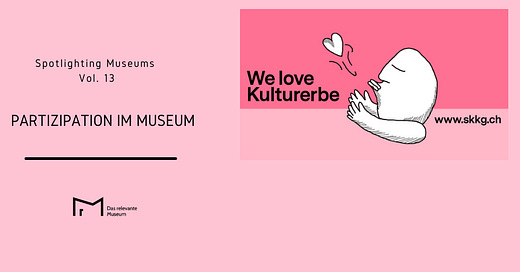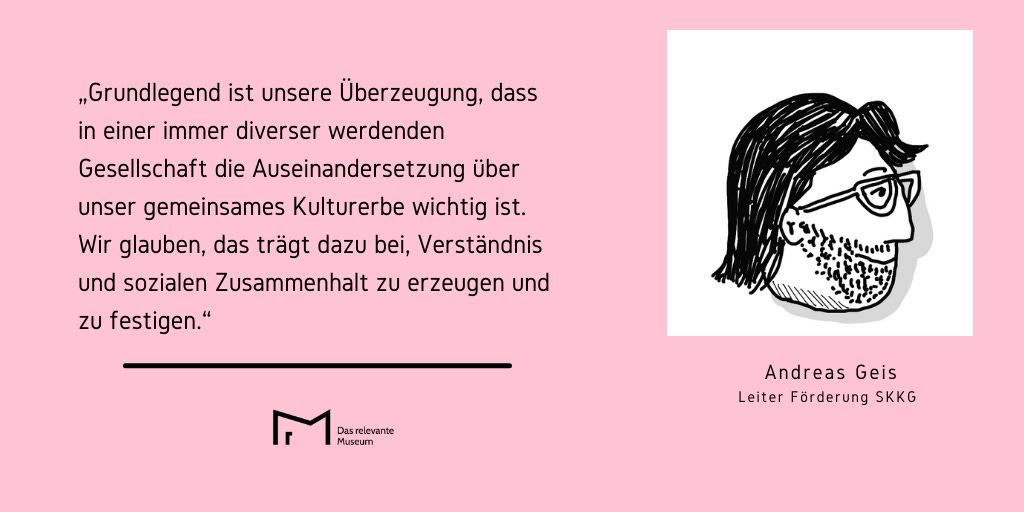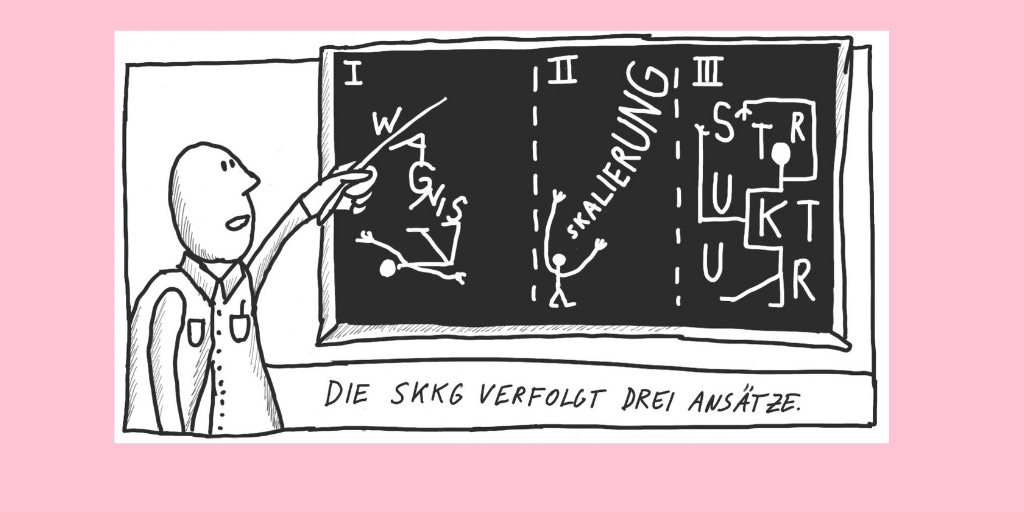© Moriz Oberberger
Please find the English version below
Wunderbar, dass Sie reinschauen. Heute richten wir ein „Spotlight“ auf die Förderungstätigkeiten der Stiftung für Kunst, Kultur und Geschichte, SKKG.
Sie ist seit 2022 unsere Partnerin im Programm „Das relevante Museum“. Die Schweizer Stiftung will die Museen und Sammlungen zu mehr Partizipation im Umgang mit materiellem Kulturerbe beflügeln.
Eine relevante Sammlung?
Die Stiftung für Kunst, Kultur und Geschichte, SKKG, wurde 1980 vom Winterthurer Immobilieninvestor Bruno Stefanini gegründet. Bis zum Tod des Stifters bestand ihre Tätigkeit vor allem im Aufbau der über 80.000 Objekte umfassenden Sammlung an Kunst- und Kulturschätzen. Nach dem Tod des Stiftungsgründers 2018 reorganisierte seine Tochter, Bettina Stefanini, die sowohl operativ tätige als auch Förderungsmittel sprechende Stiftung neu.
Die zwei Bereiche – Sammlung und Förderung – verstehen sich als Wirkungseinheit.
Was kann der gemeinnützige Zweck einer Sammlung sein, die herausragende Kunstwerke und historische Objekte, Hoch- und Populärkultur, von der Steinzeit bis heute, umfasst? Worin besteht ihre Relevanz für die Gesellschaft?
Die Stiftung weiß es noch nicht, mögliche Antworten werden aber laufend inspiriert durch den Austausch mit den Förderungsempfängerinnen und -empfängern. Das gegenseitige Lernen voneinander und das mutige Ausprobieren neuer Ideen, auch mal das glorreiche Scheitern: das macht die Förderung der SKKG aus.
© Moriz Oberberger
Die SKKG fördert also, um daraus auch für die eigene Sammlung zu lernen und setzt dabei auf Teilhabe und Zugänglichkeit als leitende Prinzipien.
Strategisch und partnerschaftlich fördert die SKKG seit Herbst 2020 mit bis zu drei Millionen Franken pro Jahr Museen und Sammlungen in der Schweiz, die Partizipation im Kulturerbe leben und vorantreiben. Dafür wurden die drei Förderungsansätze Wagnis, Skalierung und Struktur* konzipiert.
*Wagnis ist das Projektförderungsgefäß. Immer dann, wenn ein Museum ein partizipatives Wagnis eingeht, kann und will die SKKG mithelfen. Skalierung soll diejenigen Institutionen unterstützen, die sich bereits intensiv mit dem Thema auseinandergesetzt und Partizipation zum Teil ihrer DNA gemacht haben. Mit Struktur will die SKKG die notwendigen Organisationsgefüge und Dachverbände weiterbringen. Sie weiß: Öffentliche Aufmerksamkeit für mehr Partizipation im Kulturerbe muss gemanagt werden. Außerdem können Fort- und Weiterbildungsangebote und Forschung unterstützt werden.
© Moriz Oberberger
Partizipation Partout
Was Partizipation im Kulturerbe genau bedeutet, dafür gibt es keine Blaupause. Für die SKKG ist aber selbstverständlich, dass das Ziel, das mit partizipativer Arbeit erreicht werden soll, klar sein muss. Wichtig ist auch, dass diese Debatten öffentlich geführt werden, auch im Bereich der Kulturförderung selbst.
Mit dem Kultur Komitee Winterthur wagt die SKKG einen Schritt in Richtung mehr Partizipation bei Förderungsentscheidungen: Ein zufällig ausgelostes Laiengremium vergibt dabei jährlich Kulturförderungsgelder in der Höhe von 400.000 Schweizer Franken. Das Projekt findet 2021/22 erstmals statt und wird mindestens für drei weitere Ausgaben weitergeführt und auch evaluiert.
© Giglio Pasqua
Brücken bauen
Die SKKG will nachvollziehbar und transparent sein. Das bedeutet auch, Erfahrungen und Erkenntnisse mit der Szene zu teilen. Dafür experimentiert die SKKG mit verschiedenen Förderungs- und Kommunikationsformaten, auf der Webseite und auch in den sozialen Medien.
So wurde beispielsweise in Zusammenarbeit mit der Unternehmerstiftung für Chancengleichheit und der Azurit Foundation ein Arbeitspapier zum Thema Oral Reporting ausgearbeitet. Einen Einblick in die Tätigkeiten der Stiftung gibt es laufend auf LinkedIn, Instagram und Twitter.
Um einen tieferen Einblick in die Teilhabe- und Partizipationsdebatte im Schweizer Kontext zu erhalten, empfehlen wir den Leserinnen und Leser dieses Newsletters die Dokumentationen Partizipation im Kulturerbe: Themen- und Bedarfsanalyse (Stiftung für Kunst, Kultur und Geschichte), Teilhabe am Kulturerbe – ein Leitfaden (NIKE – Nationale Informationsstelle zum Kulturerbe) und Förderung kultureller Teilhabe. Ein Leitfaden für Förderstellen (Bundesamt für Kultur) als spannende Lektüre.
Ein großer Dank an Andreas Geis, Laura Walde und das SKKG Team für diese Einblicke in ihre Arbeit und die wunderbare Zusammenarbeit im Programm „Das relevante Museum”.
In der nächsten Ausgabe nehmen wir Sie mit nach Österreich, mit Impressionen von unserem Treffen am Rande des 17. Internationalen Bodensee-Symposiums im Vorarlberg Museum in Bregenz.
Herzliche Grüße
Katja
© Moriz Oberberger
English version
We appreciate you joining us. Today we are focusing a “spotlight” on the funding activities of the Foundation for Art, Culture and History, SKKG.
She has been our partner in the “Relevant Museum" programme since 2022. The Swiss foundation wants to inspire museums and collections to participate more in the material cultural heritage.
A relevant collection?
The Foundation for Art, Culture and History, SKKG, was founded in 1980 by the Winterthur real estate investor Bruno Stefanini. Until the death of the founder, her main activity was to build up the collection of art and cultural treasures comprising over 80.000 objects.
After the death of the foundation's founder in 2018, his daughter, Bettina Stefanini, reorganised the institution, which is both, operational and funding. The two areas – collection and funding – see themselves as a unit of action.
Which charitable purpose can a collection have, that includes outstanding works of art and historical objects, high and popular culture from the Stone Age to the present day? What is its relevance for society?
The foundation does not know yet, but possible answers are constantly inspired by the exchange with the grant recipients. The mutual learning from each other, courageous attitude towards implementation of new ideas and sometimes the glorious failure: this is what characterises the funding of the SKKG.
© Moriz Oberberger
The SKKG therefore offers funding in order to learn from it for its own collection and relies on participation and accessibility as guiding principles. Since autumn 2020, the SKKG has been strategically and collaboratively supporting museums and collections in Switzerland, that live and promote participation in cultural heritage, with up to three million Swiss Francs per year.
For this purpose, the three funding approaches risk, scaling and structure* were designed.
*”Risk” is the vessel for their project funding. Whenever a museum takes a risk with a participatory project, the SKKG can and wants to help. “Scaling” is intended to support those institutions that have already dealt intensively with the topic and have made participation part of their DNA. With “Structure”, the SKKG wants to advance the necessary organisational structures and umbrella organisations. She knows that public attention for more participation in cultural heritage must be managed. In addition, further education and training opportunities as well as research can be supported.
© Moriz Oberberger
Participation Partout
There is no blueprint for what participation in cultural heritage means exactly. For the SKKG, however, it is clear that the goal to be achieved with participatory work must be defined. It is also important that these debates are conducted publicly, also in the area of cultural funding itself.
With the “Kultur Komitee Winterthur”, the SKKG dares to take a step towards more participation in funding decisions: Annually a randomly appointed lay committee awards a grant of 400.000 Swiss Francs to cultural institutions of their choice. The project took off in 2021/22 and will be continued and evaluated for at least three further editions.
© Giglio Pasqua
Building bridges
The SKKG is seeking for comprehension and transparency. This also means sharing experiences and insights with the sector. To this end, SKKG is experimenting with various funding and communication formats, on the website and also in social media.
For example, a working paper on oral reporting was prepared in cooperation with the Unternehmerstiftung für Chancengleichheit and the Azurit Foundation. An insight into the activities of the foundation can be found on LinkedIn, Instagram and Twitter.
In order to gain a deeper understanding for the debate on participation in the Swiss context, we recommend the documentaries Partizipation im Kulturerbe: Themen- und Bedarfsanalyse (Foundation for Art, Culture and History), Teilhabe am Kulturerbe – ein Leitfaden (NIKE – National Information Centre on Cultural Heritage) and Förderung kultureller Teilhabe. Ein Leitfaden für Förderstellen (Federal Office of Culture) to the readers of this newsletter as an exciting read.
We like to thank Andreas Geis, Laura Walde and the SKKG Team for these insights into their work and being a fantastic partner in the “Relevant Museum” programme.
In the next edition, we will take you to Austria with impressions from our meeting during the 17th International Lake Constance Symposium at the Vorarlberg Museum in Bregenz.
Kind regards
Katja










